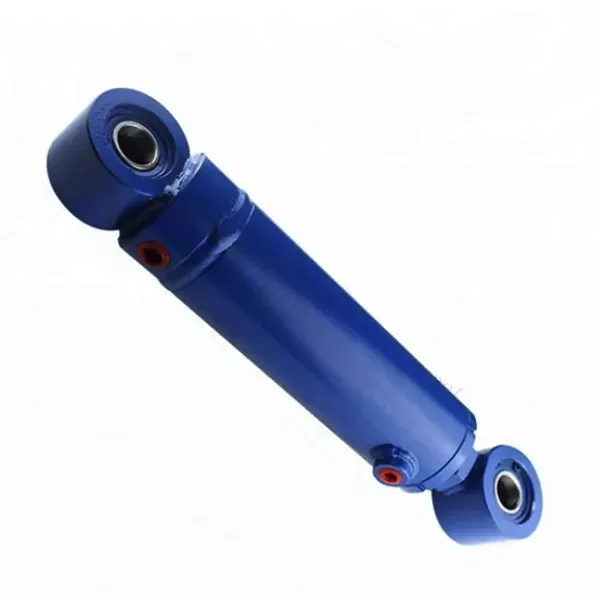活塞杆端为内螺纹杆头耳环连接工程液压缸
活塞杆端为内螺纹杆头耳环连接工程液压缸
Piston rod end – Threaded rod head earring connection Engineering hydraulic cylinder is a high-performance hydraulic component for reliable and efficient operation in various engineering applications. This product provides a safe and reliable connection between the piston rod end and the external load-bearing structure, ensuring optimal performance and smooth operation of the hydraulic cylinder.
HSG series engineering hydraulic cylinder is a double-acting piston rod hydraulic cylinder. Installation mode adopts earring type. According to the connection between the cylinder head and the cylinder block, there are three kinds of external thread connection, internal card critical connection, and flange connection. Engineering hydraulic cylinder is mainly used in construction, lifting, mining, and other hydraulic systems.

HSG Engineering Hydraulic Cylinder Parameter:


HSG Engineering Hydraulic Cylinder Usage Method:
- Identify the Internal Thread:
- Determine the specifications of the internal thread, including dimensions, pitch, and type provided by the manufacturer.
- Use thread gauges or calipers to measure the internal thread dimensions accurately.
- Select Compatible Components:
- Select a load-bearing structure or component with external threads matching the internal thread specification of the piston rod end.
- Ensure the selected components are clean, non-destructive, and comply with hydraulic system requirements.
- Thread Connection:
- Align the external threaded portion of the assembly with the internal threaded hole/socket at the end of the piston rod.
- Rotate the component clockwise to engage the threads.
- Hand-tighten the connection until it is snugly fit.
- Secure the Connection:
- Use an appropriate tool, such as a wrench or spanner, to further tighten the connection and ensure it is securely secured.
- Do not over-tighten, as it may damage threads or components.
HSG Engineering Hydraulic Cylinder 特点:
- 坚固的结构 The hydraulic cylinder is sturdy and durable, allowing it to withstand demanding engineering applications.
- Secure Connection: The internal threaded rod head earring connection ensures a reliable and secure attachment, providing stability and preventing unintended disconnection.
- Compatibility: The product is designed for compatibility with various load-bearing structures and components, offering versatility in engineering projects.
- Smooth Operation: The precise engineering of the piston rod end and internal thread ensures smooth and efficient hydraulic cylinder movement, reducing friction and enhancing overall performance.
- Easy Maintenance: The threaded connection facilitates easy inspection, lubrication, and replacement of components, simplifying maintenance tasks.
How To Disassemble A John Deere Hydraulic Cylinder?
To disassemble a John Deere hydraulic cylinder, follow these general steps:
- Preparation:
- Ensure that the hydraulic system is depressurized and the cylinder is retracted.
- Gather the necessary tools for disassembly, such as wrenches, pliers, and a rubber mallet.
- Place a clean workspace or bench with adequate space to organize and handle the cylinder components.
- Remove External Connections:
- Identify the hydraulic hoses, fittings, or other external connections attached to the cylinder.
- Use the appropriate tools to loosen and disconnect these connections, preventing hydraulic fluid leakage.
- Cap or plug the open ends of the hydraulic lines to prevent contamination.
- Secure the Cylinder:
- Place the cylinder securely in a vise or similar holding fixture, not damaging the cylinder body or rod.
- Remove the Rod End Cap:
- Locate the rod end cap, typically at the end of the cylinder opposite the piston.
- Use the appropriate wrench or socket to loosen and remove the bolts securing the rod end cap.
- Tap the end cap gently with a rubber mallet to break any seal or adhesive bond.
- Separate the Rod and Piston Assembly:
- Once the rod end cap is removed, carefully slide the rod and piston assembly out of the cylinder body.
- Support the weight of the assembly to prevent it from falling or causing damage.
- Disassemble the Rod and Piston Assembly:
- Examine the rod and piston assembly for retaining rings, snap rings, or other controlling devices.
- Use appropriate tools such as pliers or snap ring pliers to remove these retaining devices, allowing the assembly disassembly into its components.
- Take note of the order and orientation of each component for reassembly.
- Inspect and Clean:
- Inspect all the disassembled components for wear, damage, or signs of leakage.
- Clean each component thoroughly using an appropriate solvent or cleaning agent to remove dirt, debris, and hydraulic fluid residue.
- Dry the components entirely before reassembly.
- Reassembly:
- Reverse the disassembly steps, following the correct order and orientation of components.
- Apply a thin layer of clean hydraulic fluid or recommended lubricant to the seals and moving parts during reassembly.
- Ensure all components fit together correctly and are tightened to the manufacturer’s specifications.
工厂的能力和产能:
(1) 装配
我们拥有一流的自主研发装配平台。液压油缸生产车间拥有 4 条半自动提升油缸装配线和 1 条全自动倾斜油缸装配线,设计年生产能力 100 万支。特种油缸车间配备了各种规格的半自动清洗装配系统,设计年生产能力 20 万只,并配备了知名数控加工设备、加工中心、高精度油缸加工专用设备、机器人焊接机、自动清洗机、油缸自动装配机、自动喷漆生产线等。现有关键设备 300 多台(套)。设备资源的优化配置和高效利用,保证了产品的精度要求,满足了产品的高质量需求。


(2) 机加工
加工车间配备了定制的斜轨车削中心、加工中心、高速珩磨机、焊接机器人及其他相关设备,可加工最大内径 400 毫米、最大长度 6 米的气缸管。

(3) 焊接

(4) 油漆和涂料
配备中小型圆筒自动水性漆喷涂线,实现机器人自动上下料和自动喷涂,设计产能为每班 4000 件;
我们还拥有一条由动力链驱动的大型油缸半自动喷漆生产线,设计产能为每班 60 箱。


(5) 测试
我们拥有一流的检验设施和试验台,确保气缸的性能符合要求。

We are one of the best engineering hydraulic cylinder manufacturers. We can offer comprehensive engineering hydraulic cylinder stock. We also provide corresponding 农用齿轮箱.我们的产品已出口到世界各地,并凭借卓越的产品质量和售后服务赢得了良好的声誉。我们热忱欢迎海内外客户与我们联系,洽谈业务,交流信息,共谋发展。 与我们合作!
参观我们的 VR 工厂
通过以下方式参观我们的 VR 工厂
叉车液压缸如何工作?
液压缸应用:


